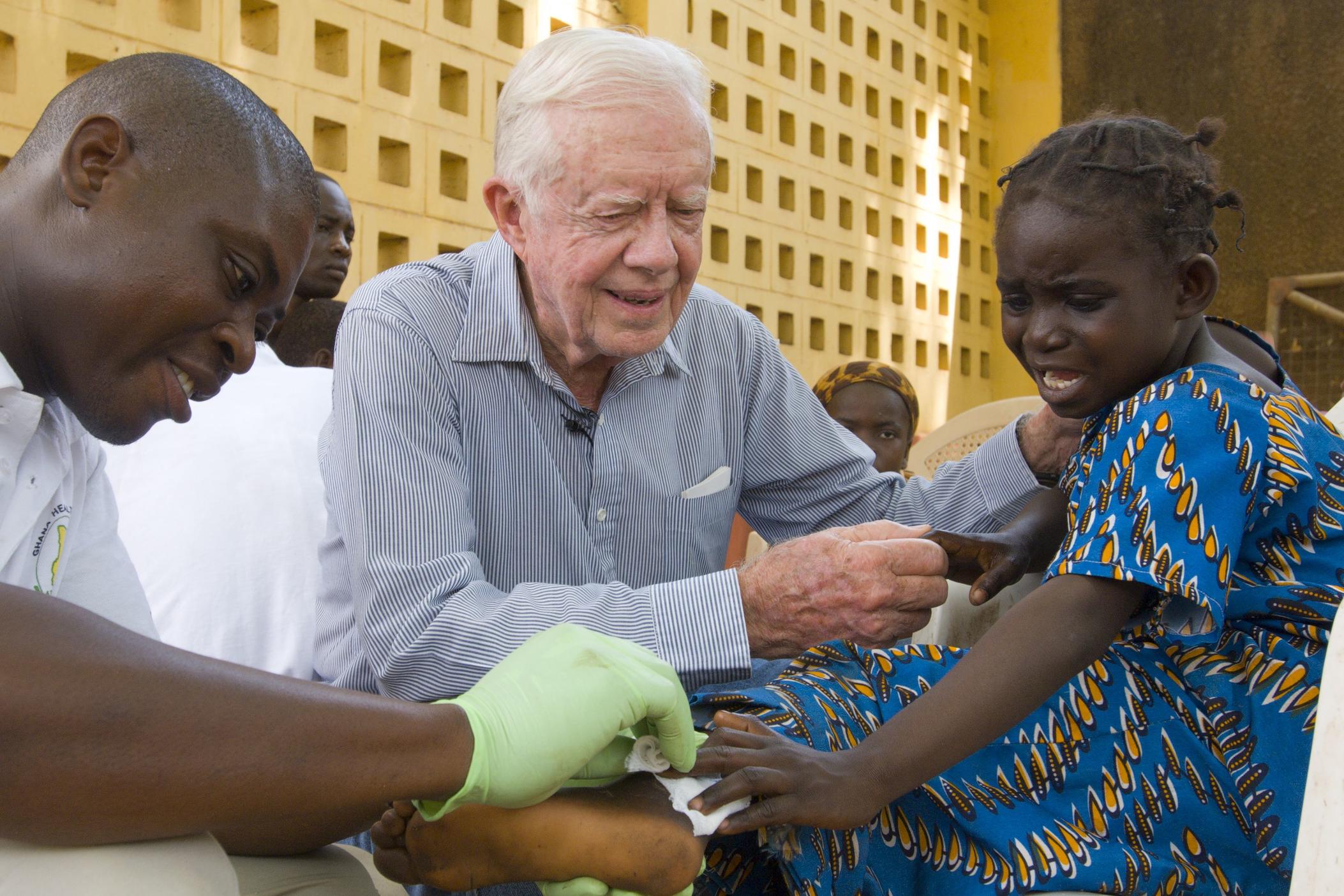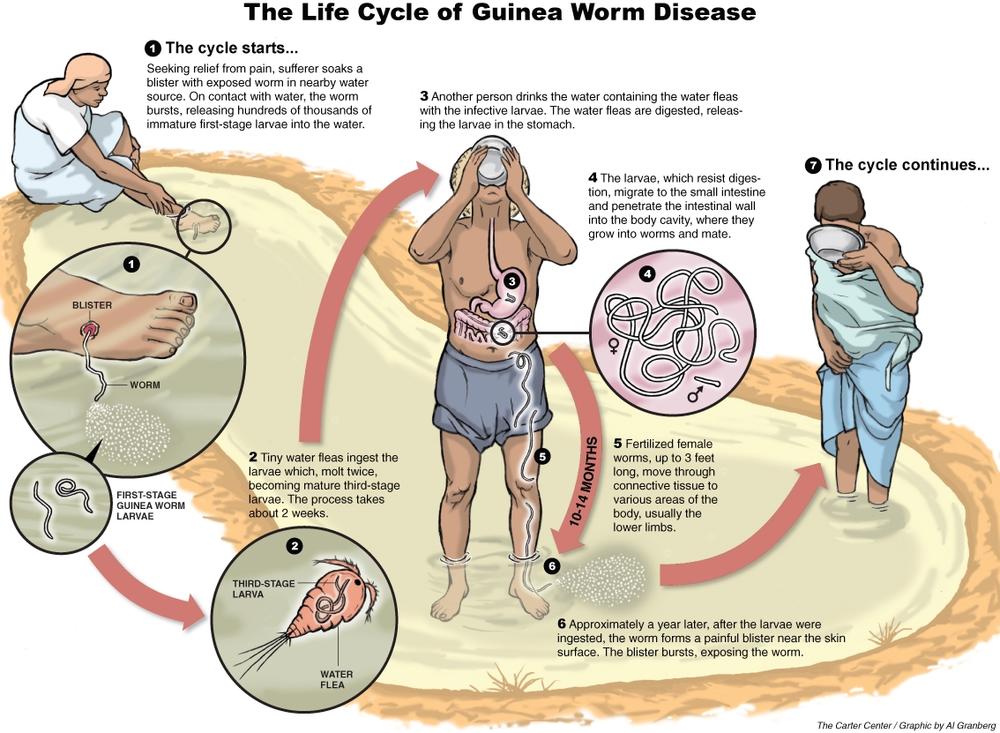
Section Branding
Header Content
Jimmy Carter and Guinea worm disease: Here's a look back at his decades of work to eradicate it
Primary Content
LISTEN: New York Times columnist Nicholas Kristof talks with GPB about former President Jimmy Carter's efforts to eradicate Guinea worm disease.
EDITOR'S NOTE: This story was originally published November 2023, after former President Jimmy Carter had been in hospice care for several months. Carter died Dec. 29 in Plains, Ga.
——
As GPB looks back on the work of the 39th president and Georgia native Jimmy Carter, one of his most impactful accomplishments is the eradication campaign to combat Dracunculiasis, best known as Guinea worm disease.
Here is a visual timeline and oral history of Carter's progress.
_____
What is Guinea worm disease and why does Jimmy Carter want to eradicate it?
Guinea worm is a biblical disease dating back 3,000 years, with evidence of the infection found in an Egyptian mummy from 1000 B.C.
In the 19th and 20th centuries, the establishment of water treatment facilities eliminated most of the disease worldwide. Unfortunately, the disease remained in developing regions of Asia and Africa with poor water quality, leading to many cases rising in those areas in modern eras.
The U.S. Centers for Disease Control and Prevention describes Guinea worm disease, a neglected tropical disease (NTD) characterized by infection caused by the Dracunculus medinensis parasite. It spreads from Guinea worm larvae found in drinking water that is unsafe for consumption. Illness in people usually comes from unfiltered pond water and “other stagnant water containing copepods (tiny “water fleas” too small to be clearly seen without a magnifying glass).”
Copepods consume the larvae, leading people who drink the copepod-filled water to become infected with Guinea worm disease. Infection can also spread between people and animals that eat aquatic animals, such as fish and frogs, that may have consumed “infected copepods and might carry Guinea worm larvae.”

By the early 1980s, the CDC began global efforts to eradicate Guinea worm under the helm of Dr. Donald Hopkins, who, during his time there, served as the assistant director for international health before becoming deputy director.

Around that same time, Carter and his wife, Rosalynn, founded the Carter Center in 1982. Its purpose was and continues to be “wage peace, fight disease, and build hope in communities worldwide.”
By 1986, there were an estimated 3.5 million cases of Guinea worm disease throughout Africa and Asia. As a result of this, the World Health Assembly (the decision-making body of WHO, the World Health Organization) and other organizations set a goal to make Guinea worm disease the second eradicated disease after smallpox.

____
1986-1994: Building the program
The years between 1986 and 1989 were the launching years, in partnership with the CDC, of the Carter Center’s Guinea worm eradication campaign.
Hopkins, who had left the CDC by this time, became the senior consultant of health programs for the Carter Center, where he led the center’s fight to eradicate Guinea worm. At this time, countries from Asia and Africa began to accept assistance from the Carter Center in hopes of reducing Guinea worm cases.
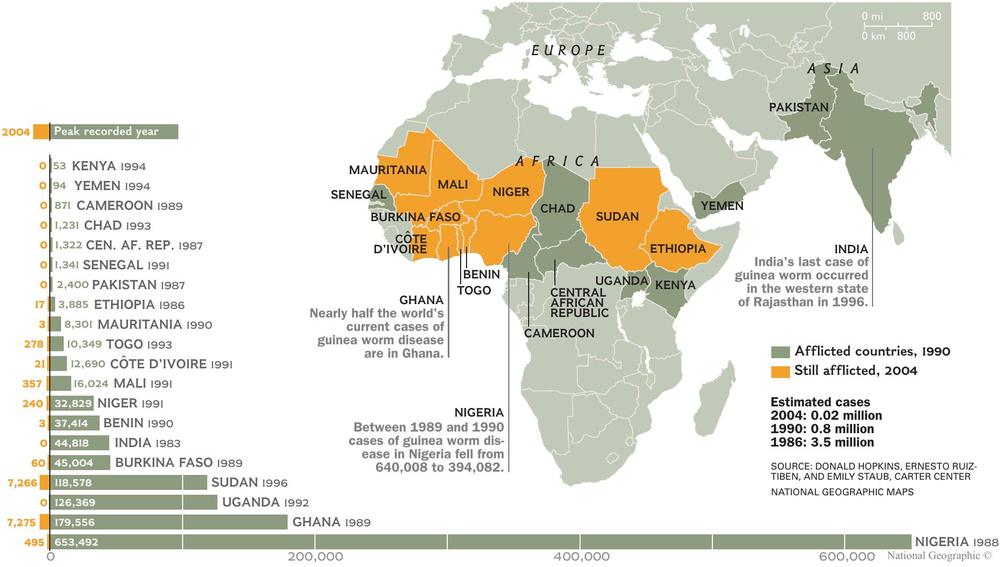
In 1988, Carter and Rosalynn visited two endemic villages in Ghana to see Guinea worm patients. The visit came after Pakistan and Ghana became the first two countries to receive assistance from the eradication campaign in 1987.
Carter recalled his visit with TIME:
“Villagers of all ages were too weak to walk or permanently scarred and crippled. As a result, a community would go hungry because its farmers were too sick to work the fields … Encountering those victims firsthand, particularly the teenagers and small children, propelled me and Rosalynn to step up the Carter Center’s efforts to eradicate guinea worm disease.”
By 1990, supporting the eradication program, the BASF Corporation began donating the Abate larvicide, which kills the water fleas carrying Guinea worm and “ensures that the parasite is unable to spread for several weeks."
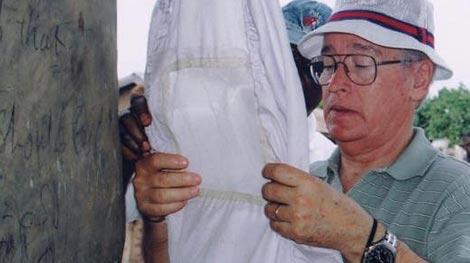
Hopkins worked with former CDC college, Dr. Ernesto Ruiz-Tiben, who later became the technical director of the Guinea Worm Eradication Program, to eradicate the Guinea worm. In their 1991 article, “Strategies for dracunculiasis eradication,” they wrote:
“Eradication of dracunculiasis is feasible for the following reasons: there is no human carrier state beyond the one-year incubation period; there is no known animal reservoir; transmission is seasonal; active detection of individuals with worms protruding from skin lesions is a sensitive means of assessing the presence of the disease in villages; the methods for controlling transmission are simple and can be targeted effectively; and the total estimated cost of global eradication (about US $75 million) is moderate.”
By 1994, Pakistan and Kenya became the first two countries of the eradication campaign to stop the transmission of Guinea worm disease, with Pakistan being the first in 1993. At this point, the Carter Center reported that fewer than 500,000 people in India, Pakistan, Yemen, and 16 countries in Africa were affected by Guinea worm compared to 3 million during the early 1980s.
____
1995-2001: Seeing results
From 1995 to 2001, several countries successfully stopped the transmission of Guinea worm disease with the help of the Carter Center. Guinea worm was officially eliminated in Asia after India stopped transmission in 1996, and Cameroon, Senegal, and Yemen followed suit in 1997. Chad and the Central African Republic stopped transmission in 1999 and 2001. Resources like donations, drug treatments and more prove to be effective in Guinea worm-infected countries as case numbers decline.
In 1995, Carter helped negotiate a six-month-long Guinea worm cease-fire in Sudan between opposing sides that had been at war for 10 years.
In a May 1995 statement from The Carter Center, the former president said:
"The cease fire has provided an unprecedented opportunity and challenge to advance health programs throughout Sudan. Through the tireless endeavors of Sudanese and humanitarian organizations, 609 of the 780 known Guinea worm infested villages already have been reached, and 595 new endemic villages already have been discovered."
At the Seventh African Regional Conference on Guinea Worm Eradication on March 1, 1998, in Mali, hundreds, including Carter and Hopkins, gathered to strategize final plans for eradication. One strategy suggested at the conference was to educate the nomadic groups in remaining countries with Guinea worm cases.
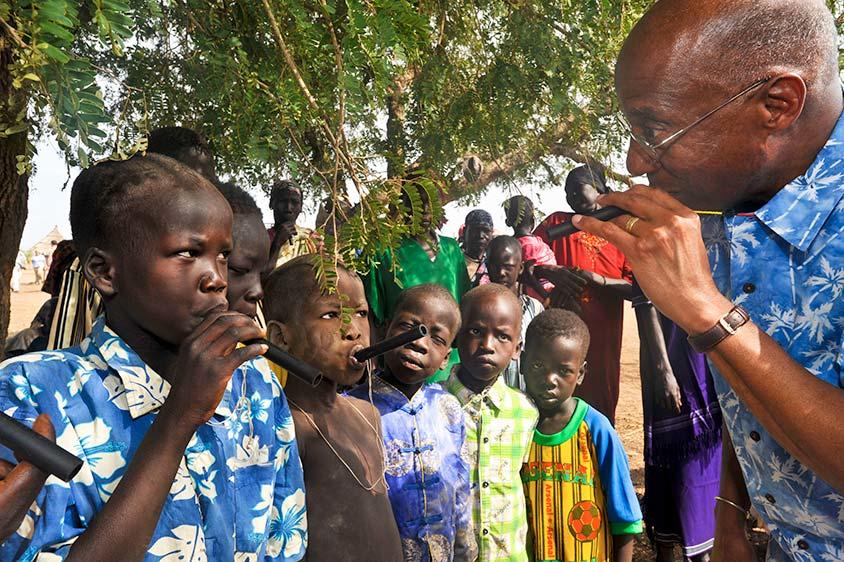
“Nomadic people can contaminate water supplies of villages through which they pass and become infected themselves by drinking contaminated water while traveling," Hopkins said at the conference, quoted in a March 1998 Carter Center press release. "We must identify effective methods to educate this special population about prevention.”
In 2001, a little less than 100,000 cases of Guinea worm remained, with the majority being in Sudan. To help reduce cases in Sudan, the Carter Center — with the help of partners Health and Development International, Hydro Polymers of Norse Hydro, and Norwegian Church Aid — distributed about 9 million pipe filters that stop the consumption of the parasite from contaminated water in Sudan, to cover each resident at risk of catching Guinea worm.
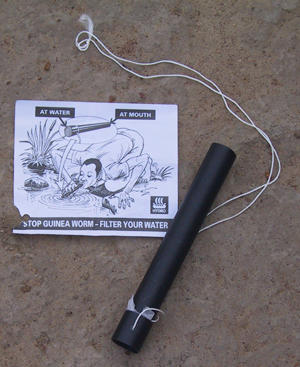
“We feel that the Pipe Filter project is the quickest and most effective solution at this time to eradicate Guinea worm disease in Sudan, given the constraints of the environment and the costs associated with providing clean water," Mikkel H. Storm, (Hydro Polymers public affairs manager, said in a May 2001 Carter Center press release. "This solution gives the Sudanese people a better quality of life without Guinea worm disease.”
____
2002-2010: The 'Nobel effect'
Within these eight years, Carter received the esteemed Nobel Peace Prize; cases of Guinea worm continued to show significant improvements based on decreasing numbers; Carter and Carter Center associates made several trips to countries on behalf of the eradication program; and plans were set in motion to eliminate Guinea worm disease in the remaining countries with it.
In his 2002 Nobel Peace Prize acceptance speech, Carter said: "Most of the Carter Center's [work] is in remote villages in the poorest nations in Africa and there I have witnessed the capacity of destitute people to persevere under heartbreaking conditions. I have come to admire their judgment and wisdom, their courage and faith in their awesome accomplishments when given a chance to use their innate abilities.”
By 2003, fewer than 32,000 Guinea worm cases were reported, a 99% decrease since the eradication program began in 1986. By then, Northern Sudan and Uganda had stopped transmission, which was significant for Uganda, once the third-most endemic country in the world.
Guinea worm remained in countries including Ghana, Nigeria, and South Sudan, accounting for more than 90% of the cases left. Ruiz-Tiben spoke in his Carter Center profile about the challenges facing South Sudan eradication.
“The war and the absence of infrastructure in southern Sudan make it very difficult to organize a program in endemic villages," he said. "We hope a peace agreement will come this year, and we pray that stability comes to the people of Sudan soon. They have suffered long enough from a disease that can be prevented.”
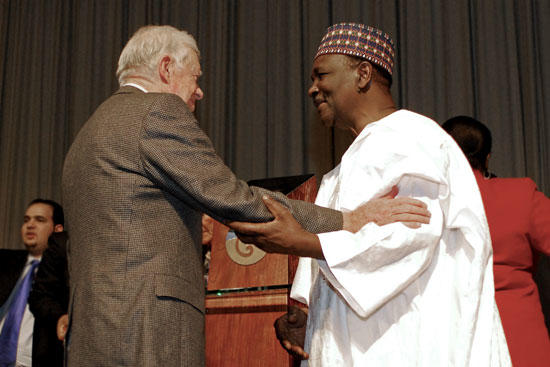
In 2003, according to the Carter Center, “Ghana boldly stepped up its surveillance this past year by recruiting more than 6,200 women Red Cross volunteers to tend to Guinea worm eradication.” The recruitment of women volunteers was seen as beneficial to eradication, as women of villages are the ones that collect and filter water for their homes, and they also “get around a village more than men, so they’re better able to detect new cases.” With better surveillance from women volunteers, they can accurately report unreported cases.
“That’s actually a positive development," Nwando Diallo, then resident technical advisor for The Carter Center’s Ghana health program, said in a December 2003 Carter Center press release. "If we don’t detect cases, we can’t treat and contain them — in other words, keep victims from spreading the disease.”
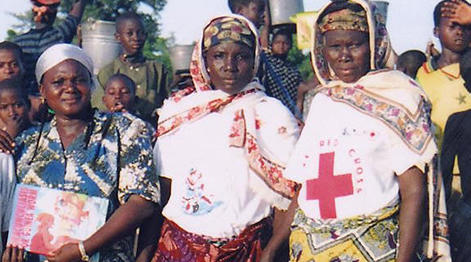
In 2007, former President Carter and former first lady Rosalynn Carter joined a Carter Center visit to Ghana to evaluate Ghana's progress with Guinea worm disease. During their stay, they observed health workers tending to those with Guinea worm, including children. The trip was the first destination of a two-week health tour of remote African villages.
According to the Carter Center, the purpose of the tour was "to call international attention to health needs among impoverished communities in Ghana, Sudan, Ethiopia, and Nigeria in February 2007."
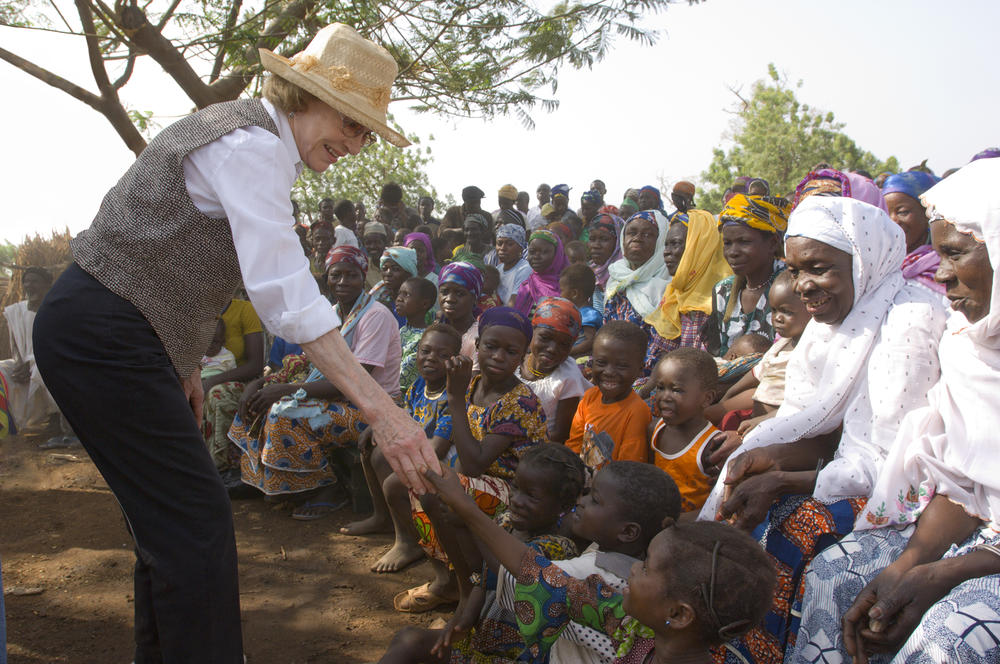
In 2009, Nigeria reported its last case of Guinea worm, overcoming the 20-year fight to eradicate the disease.
In a December 2009 Carter Center press release, Dr. Yakubu Gowon, former Nigeria Head of State General, said: “We are staring history in the face as the public health system of Nigeria is about to make a bold statement eradicating Guinea worm disease in Nigeria after many years; over two decades of hard fought battle against Guinea worm have not succeeded in defeating it.”
In 2010, Ghana officially stopped transmission of Guinea worm in the West African nation. The same year, Carter and Carter Center associates visited South Sudan's bush area because it had the most remaining cases out of the few countries that had yet to stop transmission. While on this trip, Carter urged stronger efforts to stop the transmission of Guinea worm cases ahead of the April transmission season.
The Carter Center invited New York Times reporter and author Nicholas Kristof on the South Sudan trip. Throughout his career, Kristof reported on President Carter's and the Carter Center's work with eradicating Guinea worm.
"I think Guinea worm is the quintessential Jimmy Carter quest," Nicholas Kristof told GPB. "It's something that improves a lot of lives, but it doesn't get a lot of attention. It affects principally really poor people in really remote parts of the world. Carter had this incredible vision of not just mitigating the problem, but of eradicating the disease."
On the 2010 trip, Kristof got a firsthand experience of the conditions for South Sudan residents diagnosed with Guinea worm. One of the people Kristof met on the trip was Anyak, a young Sudanese boy affected by Guinea worm, which Kristof got to witness the team help remove.
"Here I am in the middle of nowhere in South Sudan, and there's this team of people dispatched by the Carter Center working in this very remote area to try to make sure this disease goes away forever," Kristof said about meeting Anyak. "The beneficiary of this [work] is this South Sudanese kid who has no connections and is illiterate. Yet, he's got the force of the Carter Center behind him because they know that if they can stop the transmission of Guinea worm disease there, then that will mean that his children and his grandchildren, his great-grandchildren, and other people around the world won't suffer it either. So it's this combination between one of the most powerful people who held the most powerful office in the world and the beneficiary who is one of the least powerful people on the planet."
____
2011-2016: Sustaining success
In the five years from 2011 to 2016, The Carter Center remained focused on eradicating what’s left of the Guinea worm disease cases. Scientists and experts reported some of the lowest case numbers during this period. The Carter Center set its attention on expanding its responsibilities in the remaining few countries to reduce numbers further and publicly display the work they’ve done in the eradication program since its start over 30 years ago. Though he was dealing with issues relating to his health at this time, Carter shared that he wished to see the end of Guinea worm before his time was up.
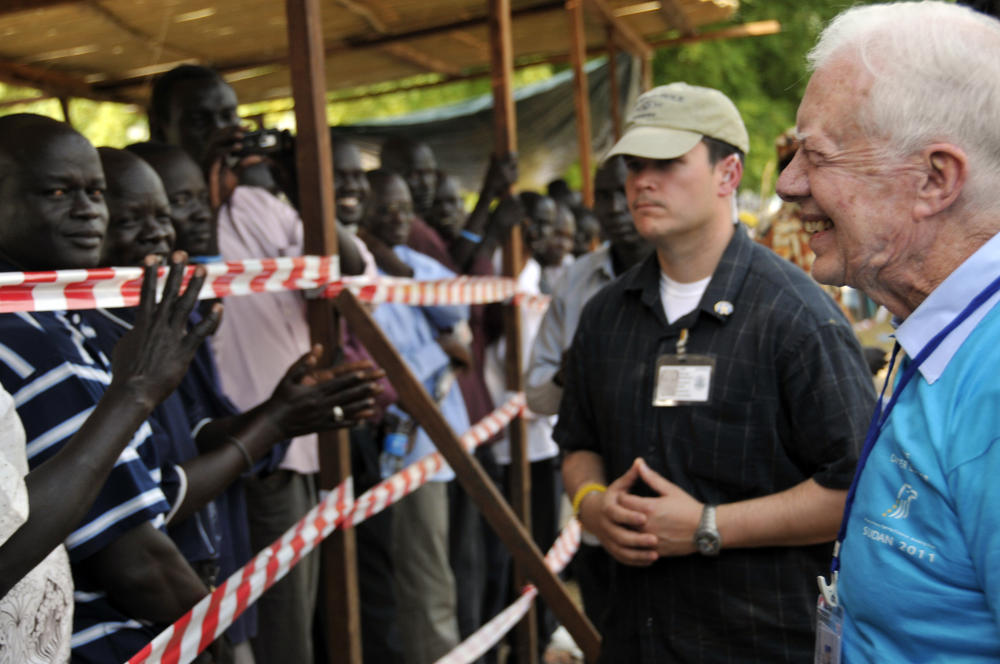
In February 2011, during the 2011 Carter Center Awards, Carter said that the Guinea worm eradication program only had three countries left to target: southern Sudan, eastern Mali, and western Ethiopia.
“The last cases of any disease are the most challenging to wipe out, especially when stability is threatened in the endemic communities of Southern Sudan and Mali," Hopkins said at the Carter Center awards (as quoted in a February 2011 Carter Center press release). "But we know that with the international community’s support, eradication of Guinea worm disease is not a question of if, but when."
By July 2011, then-Ghana Vice President John Mahatma announced that the country had gone through 14 months without any reported cases of Guinea worm, marking the 23-year end of Guinea worm in Ghana — though was not until 2015 that the World Health Organization officially classified Ghana as Guinea worm-free.
In an April 2013 interview with The Daily Show with Jon Stewart, Carter shared that in the previous year, there were only 542 reported cases of Guinea worm, with 521 being from South Sudan and the rest in Chad, Ethiopia, and Mali. At an early 2013 press conference, Carter, Hopkins, and Guinea Worm Eradication Program Director Dr. Ernesto Ruiz-Tiben, announced that the 542 cases were the lowest case totals in the campaign's history.
But Ruiz-Tiben tempered the good news at the press conference: “The success or conclusion of the global campaign over the next few years is now compromised by the situation [war] in Mali.”
Those next few years would bring successes, such as Jan. 13, 2015, the opening day for the Countdown to Zero: Defeating Disease exhibit at the American Museum of Natural History, which collaborated with The Carter Center to “focus on several global efforts that have been able to contain, eliminate, or eradicate disease.”
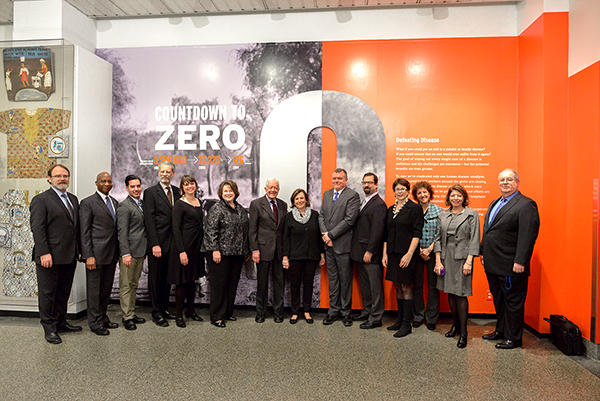
Ellen V. Futter, president of the American Museum of Natural History at the time, said in a January 2015 Carter Center press release: "The Museum is very pleased to collaborate with The Carter Center to present this exhibition on a critically important challenge in the 21st century, the control and eradication of infectious disease….This exhibition and the work it highlights are fully aligned with the Museum's efforts to advance scientific understanding of ecosystems within and without the human body and their interrelationship with one another…”
Also happening in 2015: South Sudan went seven months without any new reported cases of Guinea worm and only 22 cases reported globally, making it the “greatest single percentage reduction of human cases in the history of the global campaign.”
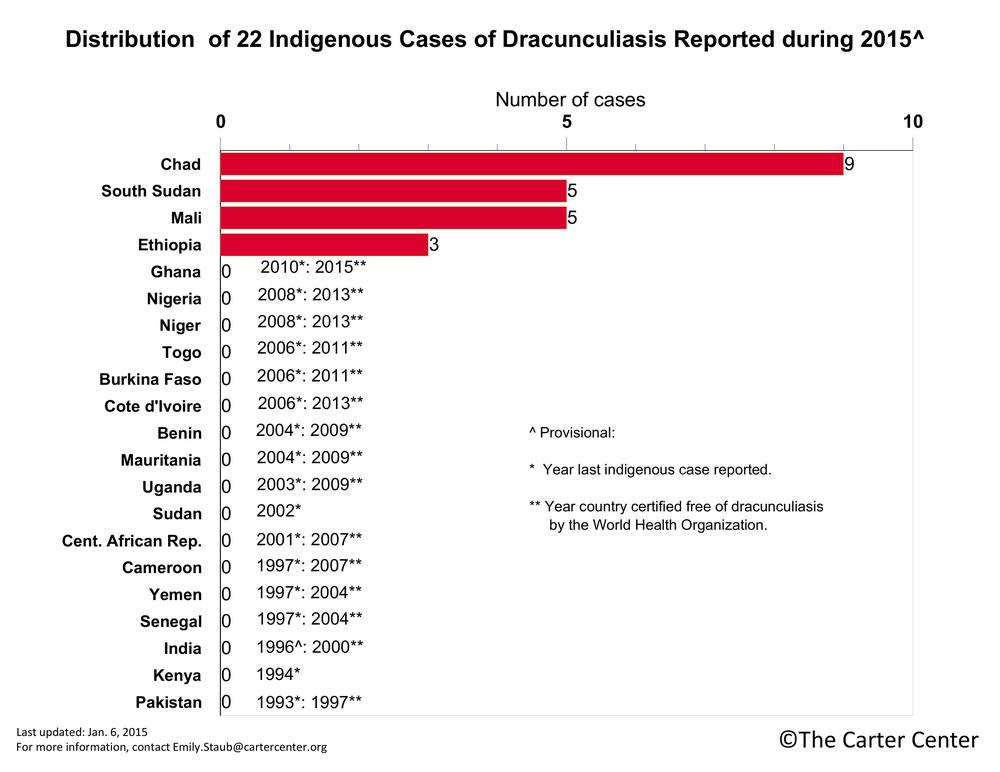
On Feb. 3, 2016, Carter visited the Palace of Westminster at the House of Lords to speak to the United Kingdom Parliament on the continued fight for Guinea worm eradication.
“This year, to combat lymphatic filariasis, schistosomiasis, trachoma, river blindness, Guinea worm and others, our Carter Center goal is to administer 81 million doses of medications," Carter said in his lecture. "Last year, we only had 22 cases in 20 villages in the entire world. So this debilitating disease is on the brink of eradication ... We've had some unexpected developments during this last 30 years of our eradication program. The greatest remaining challenges are from insecurity in parts of Mali, South Sudan, and Ethiopia. The only other country is Chad. But we still have civil wars in some of those countries and it makes it impossible almost for us to get filter cloths or workers to go in and help eliminate the disease. This is a very serious problem.”
____
2017-2023: Reaching for zero
The ultimate goal for the eradication program between 2017 to 2023 was to eradicate Guinea worm cases — a goal near realization as some of the last few countries with Guinea worm reported zero cases annually, and officials from those countries vowed to work to eradicate the disease completely.
President Carter was not as present as he once was for the eradication program as he dealt with health concerns. Still, other Carter Center representatives and experts stepped up on behalf of the eradication campaign.
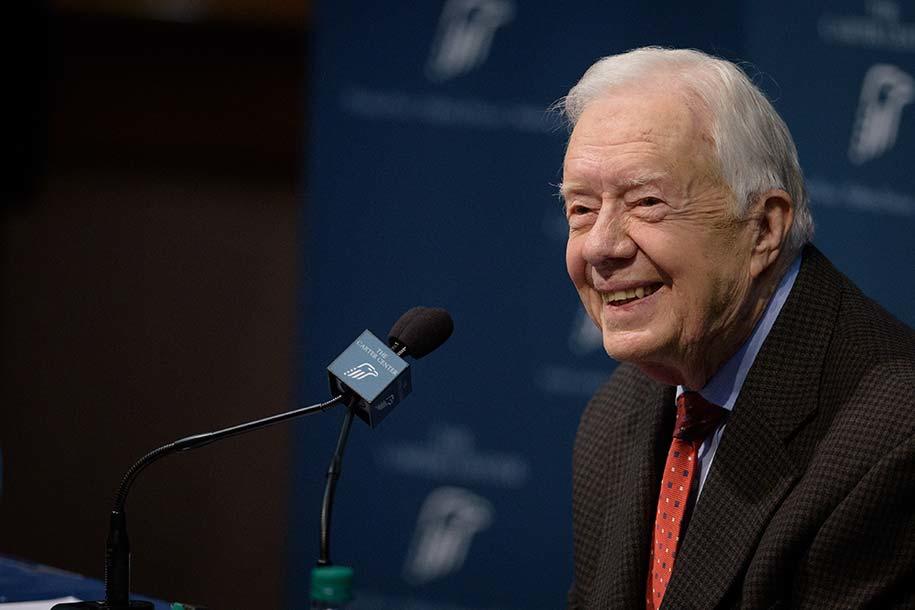
On Jan. 11, 2017, the Countdown to Zero: Defeating Disease exhibit opened at the Jimmy Carter Presidential Library and Museum for public view.
“Public health has been one of the pillars of Jimmy and Rosalynn Carter’s post-White House contributions to the world, and we are delighted to give the public some insight into how these efforts work," said Dr. Meredith Evans, director of the Jimmy Carter Presidential Library and Museum, in a January 2017 Carter Center press release.
The Carter Center shared in 2017 that Mali had not reported any new cases of Guinea worm in a year since the Mali Guinea Worm Eradication Program began in 1992, leaving only three countries with Guinea worm.
“The progress we have seen in restricting Guinea worm disease to these few cases in only three countries is a testament to the dedication of people in endemic areas to caring for their health and that of their communities,” Dr. Dean Sienko, Carter Center Vice President of Health Programs, said in a January 2017 Carter Center press release.
On March 21, 2018, a live press conference was held in Atlanta to brief the public and media on status updates on the eradication campaign, and in a shocking turn of events, former South Sudan Minister of Health Riek Gai Kok made a surprise announcement that South Sudan has stopped transmission of Guinea worm.
“This achievement it because we have that sense of common humanity," Kok said at the press conference. "This achievement is great because the difficulties that we faced as a country, no one would imagine that South Sudan can come out with this result of achieving zero cases.”
But shortly after Kok's announcement, cases of Guinea worm in South Sudan came back. After discovering Guinea worm in "newly pacified areas," South Sudan announced 10 new cases by the end of 2018.
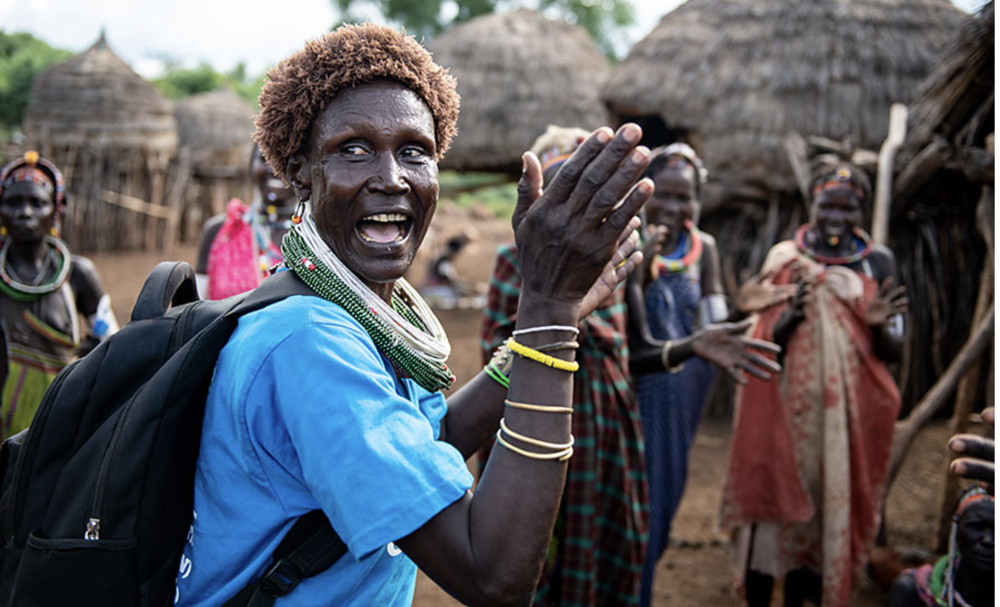
To help reduce cases in South Sudan, Regina Lotubai Lomare Lochilangole, a social mobilizer, created an original song and dance that helped teach community members about Guinea worm prevention and related symptoms.
"Song and dance are common [within our culture] for occasions and ceremonies," she said in an August 2021 Carter Center press release. "We sing them in our villages and when working outdoors. I am happy these songs have reached to other areas."
The South Sudan Ministry of Health recognized her work and gave her a position with their Guinea Worm Eradication Program.
In 2019, only 54 Guinea worm cases were reported, with 47 cases coming from Chad, which at that point had the largest number of Guinea worm cases left in the world.
From March 20 to March 22, Abu Dhabi held the 2022 Guinea Worm Summit, where world leaders and representatives “gathered to recommit themselves to taking the steps needed to eradicate Guinea worm disease by 2030.” At the summit, representatives from several African countries signed the Abu Dhabi Declaration on the Eradication of Guinea Worm Disease.
“Thanks to the commitment of The Carter Center and partners around the world, we have made incredible progress towards ending Guinea worm disease — but the work is not over," Sheikh Shakhbout bin Nahyan Al Nahyan, Abu Dhabi Minister of State in the Ministry of Foreign Affairs and International Cooperation, said in a March 2022 Carter Center press release. "This week we were honored to convene global champions of the eradication effort in Abu Dhabi to renew our shared commitment towards reaching that last mile of disease eradication.”
As of January 2023, the Carter Center said there were only 13 reported human cases of Guinea worm disease globally, making it a massive step towards eradicating Guinea worm.
Adam Weiss, the current Guinea Worm Eradication Program Director for the Carter Center, said in a January 2023 press release: “We continue to study ways to defeat and prevent this infection. Community members, ministries of health, and our parents are working with us to implement interventions that are effective, including research to find innovative solutions. We won’t stop until the last Guinea worm is gone.”
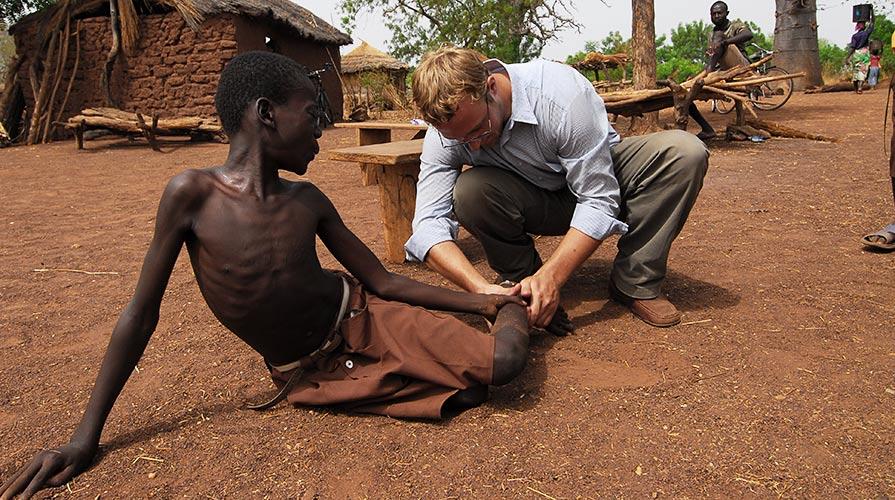
Weiss's role involves coordinating among the remaining endemic countries and various partners, including academic and research partners, in providing technical, administrative, and financial support to help eradicate Guinea worm disease.
In an August 2023 interview with GPB, Weiss said there is a decline in cases of humans infected with Guinea worm.
"As of today, there are only two human cases so far this year," he said.
According to Weiss, the factors that continue to contribute to the remaining cases of Guinea worm lie in the areas where Guinea worm is rampant are places that don't have the resources for a strong health care system.
"I wouldn't necessarily call it a disease of poverty, but what it is, is a disease that affects people in areas that are often marginalized politically, socially, socially, economically for a whole host of potentially different reasons," Weiss said. "Ultimately, it represents a lack of development. They don't necessarily have access to safe water. They don't necessarily have access to sanitation. They don't necessarily have access to health services in general."
"Often," he said, "the communities where guinea worm is still endemic are places where if you go to a health service provider, you might be able to access paracetamol or Tylenol, but you're not going to get much more additional care than that. And that's if those services are even accessible in the first place. And that lack of infrastructure drives diseases like guinea worm and other neglected tropical diseases."

___
The future and Carter's legacy
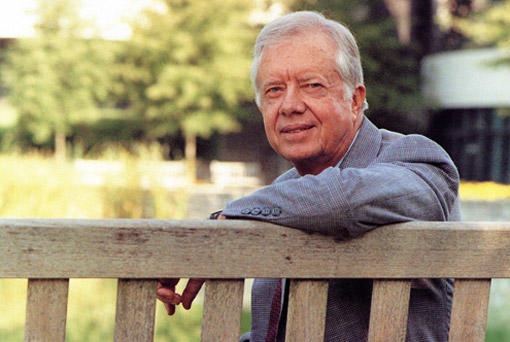
In February 2023, the Carter family shared that President Carter would continue his hospice care at home to be around family and friends after a few periods in the hospital.
After the announcement, many who have worked closely with Carter, whether with the Carter Center or in different environments, reflected on what they will remember about Carter's work with the Guinea worm disease for nearly 40 years.
Nicholas Kristof reflected on how people will remember Carter's legacy through his ambition to make his wishes and goals a reality.
"I think one of the things that have characterized President Carter throughout his career has been an incredible ambition, not just to make incremental progress, but to pick these goals that are in many ways just completely unreasonable," Kristof said.
"When he said he was going to run for president, his mom asked him, 'President of what?'" Kristof continued. "And that's his mother!"
Kristof continued: "And to bring about Middle East peace or to take this obscure disease and not just mitigate its impact, but to eradicate and make it the second human ailment after smallpox to be completely eradicated. I think that it does reflect this vaulting ambition that has been characteristic of President Carter."
"He told me a couple of times that his ambition in life, his goal, was to outlive Guinea worm disease and that he wanted it gone before he goes," Kristof said. "And we'll see."
Adam Weiss said Carter's legacy lies in his work recognizing Guinea worm as a genuine concern worldwide and finding ways to help reduce the millions of cases reported annually.
"I think the legacy of President Carter's has always been about action," Weiss told GPB. "Of course, he did his due diligence and understood the problem, but then found and implemented solutions. You might not have all of the information, and you might not have a golden arrow or a silver bullet solution, but you do what you can. He has a famous quote: 'You do what you can when you can with what you have.'
"That sentiment shines through everything that the Carter Center has done."
Resource materials, including datelines, photographs, graphics and videos for this story were provided by The Carter Center, unless otherwise noted.
